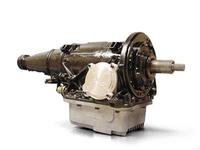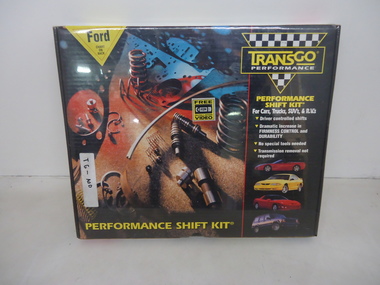Using an Automatic Transmission for Performance
Manuals may be praised by car enthusiasts, but if you visit your local drag strip, you’ll find most people are running automatics. What is it that makes these transmissions so popular, and how can you use one to cut your ETs?

When You Think “Automatic,” Think
“Planetary”
Most automatic transmissions are built around a planetary gearset. Even
“manual” transmissions used on top fuel dragsters use this design, allowing the
driver to operate the clutches to shift gears instead of using a valve
body.
A planetary gearset uses three sets of intermeshed gears. To shift gears, the
transmission switches which sets are connected to the input and output shafts.
This is faster than disengaging a synchro and engaging another synchro in a
manual transmission.
A stock transmission is built to provide smooth shifts and good fuel economy.
By changing the clutches, valve body and torque converter, a planetary gear
transmission can change the gear connection quickly and keep the engine running
at high RPM to get power down faster than a traditional manual.
Torque Converter
This fluid transfer device replaces the clutch on a manual transmission. The
engine drives an impeller which moves fluid to push the turbine connected to
the transmission input shaft. In between these parts is the stator, which
pushes circulating fluid back to the vanes of the impeller. Modern converters
also have a lock-up clutch that connects the turbine and impeller directly,
eliminating fluid power loss. If the converter isn’t locked, the impeller can
spin faster than the turbine, increasing the force of the fluid which
multiplies torque. This means shifts can happen immediately, whereas the engine
speed must drop for the flywheel and clutch speeds to match when shifting a
manual. This torque multiplication also allows automatics launch harder than
manuals.
Stall Speed and Trans Brakes
The stall speed is the maximum speed the engine can be at before it can’t
overcome the hydraulic pressure in the torque converter. At this point, full
force is applied to the turbine and the wheels must start turning. True stall
speed can only be measured using a trans brake, which locks both first and
reverse gears at the same time to keep the car from moving. Used together, a
high stall speed converter and a trans brake allows the engine to rev up to its
peak torque band before launch. Putting a transmission in two gears at the same
time is hard on internal components, so most street-driven drag cars use the
brakes to hold the car back instead.
Contrary to popular belief, stall speed is not how fast the engine needs to be
turning for the car to move. There’s still some power transfer below this
speed, letting the car be driven normally; issues with drivability usually
don’t occur unless the stall speed is over 3,000 RPM, which is well within the
start of the peak powerband on a heavily modified V8. That’s a big jump from
the near-idle speed of a stock converter, and it can mean launching your car
near its peak output, shaving serious time off or your runs, especially at the
60-foot mark.
Real world performance will differ from the rated stall speed. If you don’t
have a trans brake, the maximum RPM at launch will be determined by what your
rear brakes can hold. If your engine makes more power than what was used to
test the stall converter, the stall speed will be higher, and if you have less
power, the stall speed will be lower.
Fitting a Pre-Built Automatic
If this is starting to sound complicated, don't worry: we carry Performance
Automatic transmissions, which are built around the C4, a three-speed automatic
that Ford built from 1964 to 1981. Originally used with straight 6’s and small
block V8s, this design can be modified to handle enormous amounts of power. They
take the guesswork out of shift points and stall speeds, using race-proven
formulas so you can get something that will work with your engine.
These transmissions are available in case fill and pan fill versions. While
factory pan fill versions have a reputation for strength, there’s no real
difference in durability with a performance transmission. This makes choosing a
transmission a matter of fit: bellhousings aren’t interchangeable due to the
shape of the cases, and the long dipstick tube on the pan fill transmission may
get in the way of some headers.
Want to get better performance from your stock transmission? We also offer a TransGo shift kit to get better shifts out
of the AOD used in Fox Body (86-93) Mustangs.
Get the Transmission You Need for the
Strip
Anderson Ford Motorsport doesn’t just sell Mustang parts, we’ve raced in NHRA
and have spent over three decades testing and developing performance
parts for Mustangs. Whether you decide to go with an automatic or a manual, we have
everything you need from complete transmissions to shifter and bellhousings.
Recent Posts
-
Bringing the Fox Body Mustang into the 21st Century with Holley Terminator X
Anderson Ford Motorsport has been in the Fox Mustang performance industry since 1989. One of the bi …22nd Oct 2021 -
Roush Supercharger install on a 2019 Ford Mustang
Check out this 2019 Ford Mustang before and after we installed a Roush Supercharger. …21st Feb 2020 -
All Blower Installations are not Equal.
Why Should You Choose a Company to Install Your Blower That Has a Dyno Facility In-House?Are all de …24th Jan 2020


